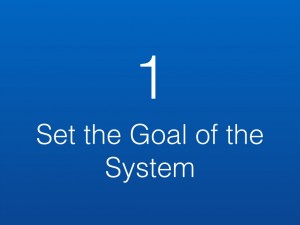If there is no goal, then there is no system.
What is a system? We can define a system as a network of interdependent components that work together to achieve the goal of the system.
In other words, everyone and every process in an organization have to work together systemically in order to achieve the goal of the system.
Choosing our goal, deciding how we want to achieve it, and communicating these decisions to everyone means essentially getting our ideas straight and aligning the values of those who work in the organization. In other words, we create a common vision.
How can we do this? It’s not enough to verbalize a goal. We need to understand what a goal is that is suitable for our organization and its capacity. We can do a very good job of this by deriving our goal using one of the Thinking Process Tools from the Theory of Constraints, The Core Conflict Cloud.
This powerful cognitive tool will take us through the process of:
- idenitifying our Undesirable Effects
- identifying the true needs of our organizations (vision and fears)
- verbalizing a realistic goal based on the above
- thoroughly surfacing our mental models/assumptions
- knowing what keeps us stuck and what needs to be addressed to move forward towards the goal
Measuring the system
In order to achieve our goal we have to know how to make the right decisions. This means we have to be able to assess how much our system is achieving its goal. This means we need to establish:
- The units the system uses to measure its progress toward the goal;
- A set of measurements suitable for assessing the impact of every local decision on the goal of the system. This in itself forms an adequate support tool for decision-making.
If we continue to use a set of measurements that encourages individuals and single departments to optimize their local performances, we undermine the shared vision we established before. It is the strength of this shared vision that increases daily the level of cohesion among people, keeping their actions in line with the common goal.
As W. Edwards Deming points out, managers have to abandon the idea that performance can be improved by means of single functions in isolation (or even indivuduals’ “performance” levels). Managers have to continually improve the interactions of people.
So what does it make sense to measure?
We have to move away from encouraging local optima.
The Theory of Constraints uses three crucial measurements:
- Throughput
- Inventory
- Operating Expense
Using these measurements help us shift towards the mindset of growth that is the Throughput mindset, as opposed to the backward looking limitations of the cost accounting mindset.





